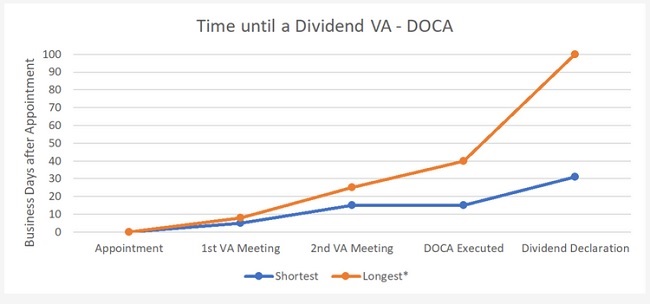When will I get paid if the Company that owes me money is placed into External Administration?
One of the most common questions we are asked as External Administrators by creditors is when and how do I get paid the money I am owed? The short answer is it depends.
For the purposes of this article, we will be focusing on the position of unsecured creditors as opposed to secured and priority/employee creditors of companies in Voluntary Administration, Subject to a Deed of Company Arrangement and in Liquidation.
The major factor that determines the timing of a dividend is the type of appointment the company is subject to.
Is the business trading on subject to a Voluntary Administrator/s ("VA") appointment?
When a VA is appointed and makes the decision to continue to trade on the business of a company, any orders they place will be paid in the ordinary course of business as they are personally liable for those pursuant to s443A and s443B of the Corporations Act ('the Act").
Those provisions provide a level of comfort to continuing suppliers/landlords should the VA take a view that it is in creditors and the company's interest to continue to trade its business subject to the appointment.
The business is in Voluntary Administration but is not continuing to trade – now what?
Post appointment of a VA, there are two meetings that are required to be held by the VA and each require five business days' notice to be provided to creditors before they are held.
The first meeting must be held within eight days of appointment (s436E) and the second meeting within five business days before or after the end of the convening period (s439A).
The convening period is twenty business days after appointment unless the appointment is within less than twenty-five business days of Christmas Day or Good Friday where the convening period is extended to twenty-five business days.
The court can also extend the convening period, or the Voluntary Administrator can seek creditors consent to adjourn the second meeting for up to forty-five business days (IPR 75-40).
At the second meeting, generally creditors will vote to accept a Deed of Company Arrangement (DOCA) proposal or to place the company into Liquidation. Each of those scenarios affect the timing of any potential dividend payment.
What happens if a DOCA proposal is accepted?
If creditors resolve to accept a DOCA proposal, it must be executed by the company within fifteen business days of the meeting of creditors at which it was accepted (s444B).
The terms of the DOCA will also influence the timing of a dividend. The funds available to creditors under a DOCA may be made available immediately or paid into the fund over an extended period.
Generally, once all funds are received in line with the terms of the DOCA, the deed administrator will call for proofs of debt, write to all known creditors whose claims have not been admitted and a notice of intention to declare dividend will be lodged on the insolvency notices website administered by the Australian Securities and Investments Commission (ASIC).
The Deed Administrator must provide at least twenty-one days after lodging the notice for creditors to lodge a proof of debt. The declaration (payment date) cannot be more than 2 months after the notice date.
In theory, the earliest a dividend can be declared and paid is 31 business days after appointment. In practice it is often longer.
The below graph provides a visual illustration of a potential dividend process in a VA/DOCA scenario.

What happens if a Company is placed into Liquidation?
In liquidation, the same timelines in relation to preparing for, declaring, and paying a dividend to creditors apply to those in a DOCA scenario. The most critical factor in a liquidation scenario is whether the liquidator can realise sufficient funds to enable a dividend to be paid to creditors.
In many liquidations, there are insufficient funds to enable a dividend to be paid to creditors. The type of business, the type of assets it owns and their appeal to a market all effect the timing of realisations and in some circumstances, this may take an extended period to complete. The Liquidator also needs to consider and pursue any voidable transactions or insolvent trading claims, if available.
These actions, if required to be pursued through the courts, can take years to resolve. Unfortunately, in a liquidation scenario the response to when a dividend may be paid is often "how long is a piece of string?" as each of the above noted items need to considered and/or pursued before any dividend may be paid to unsecured creditors.
Each individual appointment and its circumstances are different and effect the timing and quantum of any dividend payable to the Company's unsecured creditors.
The content of this article is intended to provide a general guide to the subject matter. Specialist advice should be sought about your specific circumstances.

